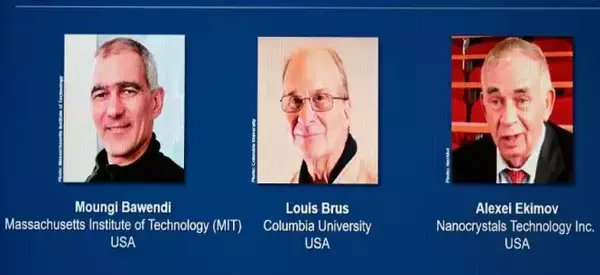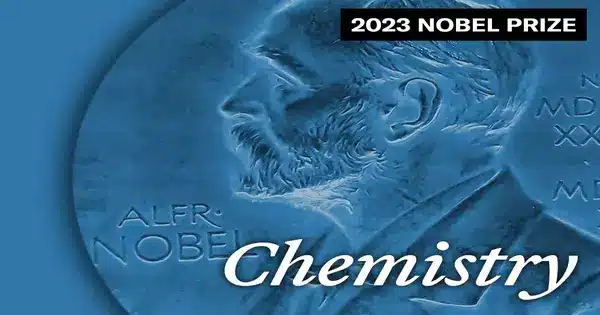Three scientists have been awarded the 2023 Nobel Prize in Chemistry for their work on tiny dots that light up TV screens and enable surgeons to detect the blood veins that feed cancer. The Royal Swedish Academy of Sciences awarded the prize for the discovery and synthesis of quantum dots to chemist Moungi Bawendi, chemist Louis Brus, and physicist Alexei Ekimov on October 4.
“Quantum dots are a new class of materials, different from molecules,” Nobel committee member Heiner Linke stated. Because of quantum mechanics, simply changing the size of these nanoparticles, which are a few billionths of a meter across, can change their properties — optical, electric, magnetic, and even melting points.
This is also true for people of color. “If you want to make different colors with molecules,” Linke explained, “you would choose a new molecule, a new set of atoms” arranged in a different arrangement. However, quantum dots of different colors share the same atom configuration. The sole distinction is the particle size.
When quantum dots are exposed to light, electrons within them get excited, releasing that energy as fluorescent light. The smaller the dots, the more they compress an electron’s wave function, increasing its energy and making the dot appear blue. Larger dots are colored red.
According to Jean-Marc Pecourt, a chemist at CAS, a division of the American Chemical Society, dots of the same size created from various materials may emit slightly different wavelengths of light. According to Pecourt, quantum dots are typically formed from semiconductor materials such as graphene, selenite, or metal sulfides. Chemists can change the properties of quantum dots by modifying the materials or the size of the dots.
Quantum dots are a new class of materials, different from molecules. Because of quantum mechanics, simply changing the size of these nanoparticles, which are a few billionths of a meter across, can change their properties — optical, electric, magnetic, and even melting points.
Nobel committee member Heiner Linke
The idea that the size of these nanoparticles could alter their properties was predicted nearly a century ago, but at the time it seemed impossible to reproduce that effect in the real world. To do that, researchers would need a perfectly crystalline material and would need to control the size of the nanomaterial very precisely, sculpting it atom layer by atom layer.
Then, in the early 1980s, Ekimov and Brus separately demonstrated that it was possible. Ekimov, who now works at Nanocrystals Technology, Inc. in Briarcliff Manor, New York, showed this in glass by adding copper chloride to create tiny crystals and revealing that the color of the glass was tied to the size of those crystals. Columbia University’s Brus made a similar discovery, but in a different context: he proved the relationship between size and color for nanoparticles floating freely in a solution and in gaseous substances.
These discoveries sparked great curiosity in how to use these tiny dots for a number of purposes. However, making them would necessitate the ability to precisely control the particle size.

Bawendi of MIT developed a method to accurately control the speed of crystal formation in a solution a decade later, figuring out how to stop them exactly when they reached a specified size. He accomplished this by first infusing chemical reagents into the solution, which instantly created the small crystals, and then quickly altering the temperature of the solution, which halted their growth.
“I’m deeply honored, surprised, and shocked by the announcement this morning,” Bawendi stated at an MIT news conference on October 4. “I’m particularly honored to share this with Lou Brus, my postdoctoral mentor from whom I learned so much.” When I came to MIT, I attempted to replicate his scholarship and mentoring attitude as a professor.”
Bawendi started working on quantum dots after he met Brus at Nokia Bell Labs, headquartered in Murray Hill, N.J. The researchers needed high-quality quantum dots to study the physics of the nanoparticles, Bawendi said. “It wasn’t because I wanted to make the best quantum dots possible for application, it was because we needed to make the best possible quantum dots to study them.” It took years of trial and error to work out the method, he said.
Bawendi’s technology opened up a world of possibilities for the nanoparticles by making it possible to make quantum dots. Quantum dots provide very accurate color changes in LED lights, significantly improving their efficiency. Fluorescent light-emitting dots, injected into the body and connected to immune cells that swarm to diseased regions, can assist surgeons in distinguishing even difficult-to-see tumors. The ability to tailor to absorb different wavelengths of light may also enable the production of bespoke solar cells that are extremely efficient in a variety of lighting circumstances. According to Pecourt, the dots could also be utilized to make quantum computers.
Biomedical engineer and chemist Warren Chan says the prize is well deserved. “They’re the ones who built the foundation,” says Chan, of the University of Toronto. “I’m really happy that the field is getting credit for really changing the world, not just in quantum dots, but in a lot of different areas.”
According to Chan, one of the first applications was in the late 1990s, when he and colleagues employed quantum dots to tag cells in the lab. “The surface modifications that were used for integrating quantum dots for applications were then also adapted for other types of nanoparticles.”
According to Chan, the Nobel committee considers not only past achievements but also the impact a discovery may have on the future. The capacity to modify nanoparticles by changing their size or surface features could open up a world of previously unexplored possibilities. Now, Chan and colleagues are utilizing quantum dots to detect infectious diseases such as HIV, influenza, and hepatitis B.
















